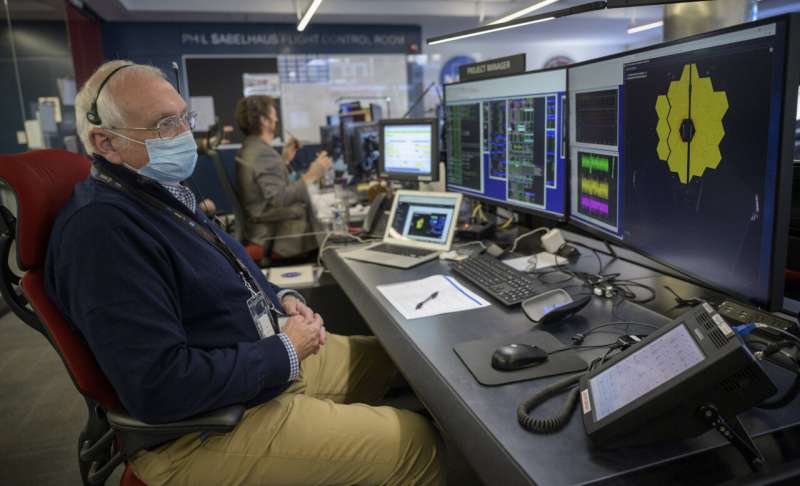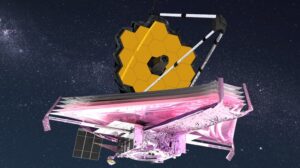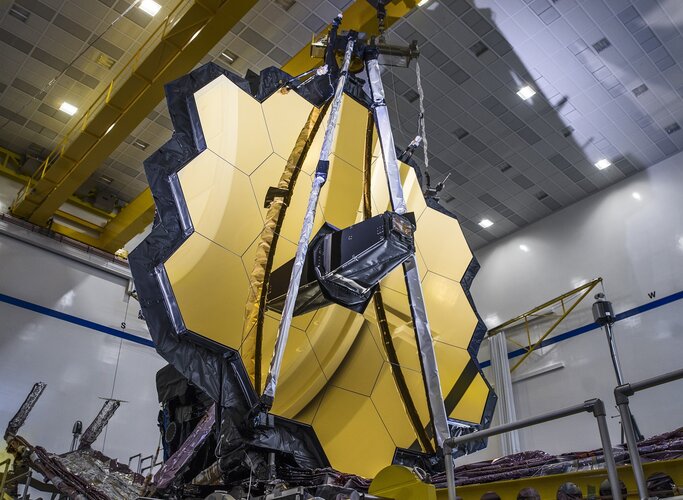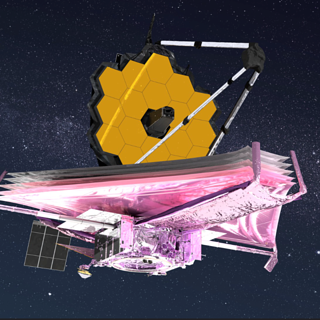Voyager Space Completes Acquisition of Space Micro
Sunday, 09 January 2022 08:30
Denver CO (SPX) Jan 06, 2022
 Voyager Space Inc. (Voyager), a global leader in space exploration has announced it has completed the acquisition of a majority stake in San Diego-based Space Micro. Voyager will provide strategic operations support to help advance Space Micro's technology throughput to civil, commercial, and defense customers.
Space Micro is an innovative, engineering-driven business focused on advancing
Voyager Space Inc. (Voyager), a global leader in space exploration has announced it has completed the acquisition of a majority stake in San Diego-based Space Micro. Voyager will provide strategic operations support to help advance Space Micro's technology throughput to civil, commercial, and defense customers.
Space Micro is an innovative, engineering-driven business focused on advancing
 Voyager Space Inc. (Voyager), a global leader in space exploration has announced it has completed the acquisition of a majority stake in San Diego-based Space Micro. Voyager will provide strategic operations support to help advance Space Micro's technology throughput to civil, commercial, and defense customers.
Space Micro is an innovative, engineering-driven business focused on advancing
Voyager Space Inc. (Voyager), a global leader in space exploration has announced it has completed the acquisition of a majority stake in San Diego-based Space Micro. Voyager will provide strategic operations support to help advance Space Micro's technology throughput to civil, commercial, and defense customers.
Space Micro is an innovative, engineering-driven business focused on advancing Arianespace to launch PLATiNO 1 and 2 on Vega and Vega C
Sunday, 09 January 2022 08:30
Paris, France (SPX) Jan 07, 2022
 Arianespace has been awarded a launch contract by SITAEL, with the Italian Space Agency (ASI) as the final customer, to orbit PLATiNO 1 and 2 satellites, between 2022 and 2024 on Vega and Vega C.
PLATiNO 1 and 2 are Earth observation small satellites operating on Sun-synchronous orbits. PLATiNO 1 will embark a Synthetic Aperture Radar (SAR), operating in the X band, while PLATiNO 2 will ca
Arianespace has been awarded a launch contract by SITAEL, with the Italian Space Agency (ASI) as the final customer, to orbit PLATiNO 1 and 2 satellites, between 2022 and 2024 on Vega and Vega C.
PLATiNO 1 and 2 are Earth observation small satellites operating on Sun-synchronous orbits. PLATiNO 1 will embark a Synthetic Aperture Radar (SAR), operating in the X band, while PLATiNO 2 will ca
 Arianespace has been awarded a launch contract by SITAEL, with the Italian Space Agency (ASI) as the final customer, to orbit PLATiNO 1 and 2 satellites, between 2022 and 2024 on Vega and Vega C.
PLATiNO 1 and 2 are Earth observation small satellites operating on Sun-synchronous orbits. PLATiNO 1 will embark a Synthetic Aperture Radar (SAR), operating in the X band, while PLATiNO 2 will ca
Arianespace has been awarded a launch contract by SITAEL, with the Italian Space Agency (ASI) as the final customer, to orbit PLATiNO 1 and 2 satellites, between 2022 and 2024 on Vega and Vega C.
PLATiNO 1 and 2 are Earth observation small satellites operating on Sun-synchronous orbits. PLATiNO 1 will embark a Synthetic Aperture Radar (SAR), operating in the X band, while PLATiNO 2 will ca China's lunar rover travels over 1km on the moon
Sunday, 09 January 2022 08:30
Beijing (XNA) Jan 10, 2022
 China's Yutu 2 lunar rover has traveled more than 1 kilometer on the moon and is still working well, according to the China National Space Administration.
The administration said on Saturday that the distance traveled by the rover reached 1 km on Thursday evening. As of late that night, the robot had moved about 1,004 meters on the lunar soil.
It added that Yutu 2, the second Chinese
China's Yutu 2 lunar rover has traveled more than 1 kilometer on the moon and is still working well, according to the China National Space Administration.
The administration said on Saturday that the distance traveled by the rover reached 1 km on Thursday evening. As of late that night, the robot had moved about 1,004 meters on the lunar soil.
It added that Yutu 2, the second Chinese
 China's Yutu 2 lunar rover has traveled more than 1 kilometer on the moon and is still working well, according to the China National Space Administration.
The administration said on Saturday that the distance traveled by the rover reached 1 km on Thursday evening. As of late that night, the robot had moved about 1,004 meters on the lunar soil.
It added that Yutu 2, the second Chinese
China's Yutu 2 lunar rover has traveled more than 1 kilometer on the moon and is still working well, according to the China National Space Administration.
The administration said on Saturday that the distance traveled by the rover reached 1 km on Thursday evening. As of late that night, the robot had moved about 1,004 meters on the lunar soil.
It added that Yutu 2, the second Chinese Perseverance set to exit Seitah area
Sunday, 09 January 2022 08:30
Pasadena CA (JPL) Jan 10, 2022
 While many reflect on the past and bid it farewell, there's a lot of exciting science to come in the next year. While many were enjoying the days between the Christmas and New Year holidays in the US, at JPL we were working to finish up sampling activities at Issole. We'll soon bid an Auld Lang Syne to the Seitah region.
As lead Mapping Specialist, I get enjoy looking at the road ahead for
While many reflect on the past and bid it farewell, there's a lot of exciting science to come in the next year. While many were enjoying the days between the Christmas and New Year holidays in the US, at JPL we were working to finish up sampling activities at Issole. We'll soon bid an Auld Lang Syne to the Seitah region.
As lead Mapping Specialist, I get enjoy looking at the road ahead for
 While many reflect on the past and bid it farewell, there's a lot of exciting science to come in the next year. While many were enjoying the days between the Christmas and New Year holidays in the US, at JPL we were working to finish up sampling activities at Issole. We'll soon bid an Auld Lang Syne to the Seitah region.
As lead Mapping Specialist, I get enjoy looking at the road ahead for
While many reflect on the past and bid it farewell, there's a lot of exciting science to come in the next year. While many were enjoying the days between the Christmas and New Year holidays in the US, at JPL we were working to finish up sampling activities at Issole. We'll soon bid an Auld Lang Syne to the Seitah region.
As lead Mapping Specialist, I get enjoy looking at the road ahead for Russian rocket is in uncontrolled descent to Earth
Sunday, 09 January 2022 08:30
Washington DC (UPI) Jan 5, 2021
 A Russian rocket is expected to re-enter Earth's atmosphere Wednesday in an uncontrolled descent.
Much of the rocket is expected to burn up as it plunges through the atmosphere, so there likely will not be major damage when it hits.
According to Russia's state-run TASS news agency, the Angara-A5 heavy-lift rocket was launched Dec. 27 to test the Persei booster.
The Europea
A Russian rocket is expected to re-enter Earth's atmosphere Wednesday in an uncontrolled descent.
Much of the rocket is expected to burn up as it plunges through the atmosphere, so there likely will not be major damage when it hits.
According to Russia's state-run TASS news agency, the Angara-A5 heavy-lift rocket was launched Dec. 27 to test the Persei booster.
The Europea
 A Russian rocket is expected to re-enter Earth's atmosphere Wednesday in an uncontrolled descent.
Much of the rocket is expected to burn up as it plunges through the atmosphere, so there likely will not be major damage when it hits.
According to Russia's state-run TASS news agency, the Angara-A5 heavy-lift rocket was launched Dec. 27 to test the Persei booster.
The Europea
A Russian rocket is expected to re-enter Earth's atmosphere Wednesday in an uncontrolled descent.
Much of the rocket is expected to burn up as it plunges through the atmosphere, so there likely will not be major damage when it hits.
According to Russia's state-run TASS news agency, the Angara-A5 heavy-lift rocket was launched Dec. 27 to test the Persei booster.
The Europea Shouzhou XIII crew finishes cargo spacecraft, space station docking test
Sunday, 09 January 2022 08:30
Beijing (XNA) Jan 10, 2022
 The Shenzhou XIII astronauts in China's space station core module have completed the manual rendezvous and docking experiment with the Tianzhou 2 cargo craft, the China Manned Space Agency (CMSA) said Saturday.
At the beginning of the experiment, the astronauts in the core module teleoperated the Tianzhou 2 cargo craft to leave the front docking port of the core module's node cabin and mov
The Shenzhou XIII astronauts in China's space station core module have completed the manual rendezvous and docking experiment with the Tianzhou 2 cargo craft, the China Manned Space Agency (CMSA) said Saturday.
At the beginning of the experiment, the astronauts in the core module teleoperated the Tianzhou 2 cargo craft to leave the front docking port of the core module's node cabin and mov
 The Shenzhou XIII astronauts in China's space station core module have completed the manual rendezvous and docking experiment with the Tianzhou 2 cargo craft, the China Manned Space Agency (CMSA) said Saturday.
At the beginning of the experiment, the astronauts in the core module teleoperated the Tianzhou 2 cargo craft to leave the front docking port of the core module's node cabin and mov
The Shenzhou XIII astronauts in China's space station core module have completed the manual rendezvous and docking experiment with the Tianzhou 2 cargo craft, the China Manned Space Agency (CMSA) said Saturday.
At the beginning of the experiment, the astronauts in the core module teleoperated the Tianzhou 2 cargo craft to leave the front docking port of the core module's node cabin and mov Sol 3349: Ridges, Big and Small
Sunday, 09 January 2022 08:30
Pasadena CA (JPL) Jan 07, 2022
 Another successful drive on Mars resulted in a dusty bedrock workspace with nodules and small raised ridges in front of the rover. Curiosity also has a view towards larger scale, dark, resistant ridges that we have noticed within the more subdued and lighter coloured, more typical bedrock in this area.
The science team decided to investigate the chemistry and texture of one of the small, r
Another successful drive on Mars resulted in a dusty bedrock workspace with nodules and small raised ridges in front of the rover. Curiosity also has a view towards larger scale, dark, resistant ridges that we have noticed within the more subdued and lighter coloured, more typical bedrock in this area.
The science team decided to investigate the chemistry and texture of one of the small, r
 Another successful drive on Mars resulted in a dusty bedrock workspace with nodules and small raised ridges in front of the rover. Curiosity also has a view towards larger scale, dark, resistant ridges that we have noticed within the more subdued and lighter coloured, more typical bedrock in this area.
The science team decided to investigate the chemistry and texture of one of the small, r
Another successful drive on Mars resulted in a dusty bedrock workspace with nodules and small raised ridges in front of the rover. Curiosity also has a view towards larger scale, dark, resistant ridges that we have noticed within the more subdued and lighter coloured, more typical bedrock in this area.
The science team decided to investigate the chemistry and texture of one of the small, r Sending Life to the Stars
Sunday, 09 January 2022 08:30
Santa Barbara CA (SPX) Jan 07, 2022
 No longer solely in the realm of science fiction, the possibility of interstellar travel has appeared, tantalizingly, on the horizon. Although we may not see it in our lifetimes - at least not some real version of the fictional warp-speeding, hyperdriving, space-folding sort - we are having early conversations of how life could escape the tether of our solar system, using technology that is with
No longer solely in the realm of science fiction, the possibility of interstellar travel has appeared, tantalizingly, on the horizon. Although we may not see it in our lifetimes - at least not some real version of the fictional warp-speeding, hyperdriving, space-folding sort - we are having early conversations of how life could escape the tether of our solar system, using technology that is with
 No longer solely in the realm of science fiction, the possibility of interstellar travel has appeared, tantalizingly, on the horizon. Although we may not see it in our lifetimes - at least not some real version of the fictional warp-speeding, hyperdriving, space-folding sort - we are having early conversations of how life could escape the tether of our solar system, using technology that is with
No longer solely in the realm of science fiction, the possibility of interstellar travel has appeared, tantalizingly, on the horizon. Although we may not see it in our lifetimes - at least not some real version of the fictional warp-speeding, hyperdriving, space-folding sort - we are having early conversations of how life could escape the tether of our solar system, using technology that is with New year's mission to start new phase of exoplanet research
Sunday, 09 January 2022 08:30
Birmingham UK (SPX) Jan 07, 2022
 A mission to one of the coldest and most remote places on earth will enable a new phase in the search for distant planetary systems. University of Birmingham PhD researcher Georgina Dransfield has travelled to the Franco-Italian Concordia Research Station in Antarctica, to oversee the installation of a new state-of-the-art camera at the ASTEP (Antarctic Search for Transiting ExoPlanets) telescop
A mission to one of the coldest and most remote places on earth will enable a new phase in the search for distant planetary systems. University of Birmingham PhD researcher Georgina Dransfield has travelled to the Franco-Italian Concordia Research Station in Antarctica, to oversee the installation of a new state-of-the-art camera at the ASTEP (Antarctic Search for Transiting ExoPlanets) telescop
 A mission to one of the coldest and most remote places on earth will enable a new phase in the search for distant planetary systems. University of Birmingham PhD researcher Georgina Dransfield has travelled to the Franco-Italian Concordia Research Station in Antarctica, to oversee the installation of a new state-of-the-art camera at the ASTEP (Antarctic Search for Transiting ExoPlanets) telescop
A mission to one of the coldest and most remote places on earth will enable a new phase in the search for distant planetary systems. University of Birmingham PhD researcher Georgina Dransfield has travelled to the Franco-Italian Concordia Research Station in Antarctica, to oversee the installation of a new state-of-the-art camera at the ASTEP (Antarctic Search for Transiting ExoPlanets) telescop No returning to climate of the past even with CO2 reduction
Sunday, 09 January 2022 08:30
Pohang, South Korea (SPX) Jan 01, 2022
 While the entire world focuses on achieving carbon neutrality - zero carbon dioxide (CO2) emissions - a new research shows climate change in some regions is inevitable even if the already increased CO2 level is reduced. As CO2 decreases, the intertropical convergence zone (ITCZ) shifts southwards, which can trigger persistent El Nino conditions. El Nino refers to a phenomenon in which the sea su
While the entire world focuses on achieving carbon neutrality - zero carbon dioxide (CO2) emissions - a new research shows climate change in some regions is inevitable even if the already increased CO2 level is reduced. As CO2 decreases, the intertropical convergence zone (ITCZ) shifts southwards, which can trigger persistent El Nino conditions. El Nino refers to a phenomenon in which the sea su
 While the entire world focuses on achieving carbon neutrality - zero carbon dioxide (CO2) emissions - a new research shows climate change in some regions is inevitable even if the already increased CO2 level is reduced. As CO2 decreases, the intertropical convergence zone (ITCZ) shifts southwards, which can trigger persistent El Nino conditions. El Nino refers to a phenomenon in which the sea su
While the entire world focuses on achieving carbon neutrality - zero carbon dioxide (CO2) emissions - a new research shows climate change in some regions is inevitable even if the already increased CO2 level is reduced. As CO2 decreases, the intertropical convergence zone (ITCZ) shifts southwards, which can trigger persistent El Nino conditions. El Nino refers to a phenomenon in which the sea su Bringing the Sun into the lab
Sunday, 09 January 2022 08:30
Dresden, Germany (SPX) Jan 04, 2022
 Why the Sun's corona reaches temperatures of several million degrees Celsius is one of the great mysteries of solar physics. A "hot" trail to explain this effect leads to a region of the solar atmosphere just below the corona, where sound waves and certain plasma waves travel at the same speed. In an experiment using the molten alkali metal rubidium and pulsed high magnetic fields, a team from t
Why the Sun's corona reaches temperatures of several million degrees Celsius is one of the great mysteries of solar physics. A "hot" trail to explain this effect leads to a region of the solar atmosphere just below the corona, where sound waves and certain plasma waves travel at the same speed. In an experiment using the molten alkali metal rubidium and pulsed high magnetic fields, a team from t
 Why the Sun's corona reaches temperatures of several million degrees Celsius is one of the great mysteries of solar physics. A "hot" trail to explain this effect leads to a region of the solar atmosphere just below the corona, where sound waves and certain plasma waves travel at the same speed. In an experiment using the molten alkali metal rubidium and pulsed high magnetic fields, a team from t
Why the Sun's corona reaches temperatures of several million degrees Celsius is one of the great mysteries of solar physics. A "hot" trail to explain this effect leads to a region of the solar atmosphere just below the corona, where sound waves and certain plasma waves travel at the same speed. In an experiment using the molten alkali metal rubidium and pulsed high magnetic fields, a team from t Space telescope's 'golden eye' opens, last major hurdle
Saturday, 08 January 2022 19:17
NASA completes major JWST deployments
Saturday, 08 January 2022 18:15
The primary mirror of NASA’s James Webb Space Telescope unfolded into place Jan. 8, completing the major steps in the post-launch deployment of the giant observatory.
Webb deployment complete
Saturday, 08 January 2022 18:00
Today the James Webb Space Telescope team successfully fully deployed its iconic 6.4-metre, gold-coated primary mirror, completing the final stage of all major spacecraft deployments to prepare for science operations.
NASA’s Webb Telescope Reaches Major Milestone as Mirror Unfolds
Saturday, 08 January 2022 16:16 NASA’s James Webb Space Telescope team fully deployed its 21-foot, gold-coated primary mirror, successfully completing the final stage of all major spacecraft deployments to prepare for science operations.
NASA’s James Webb Space Telescope team fully deployed its 21-foot, gold-coated primary mirror, successfully completing the final stage of all major spacecraft deployments to prepare for science operations. 
